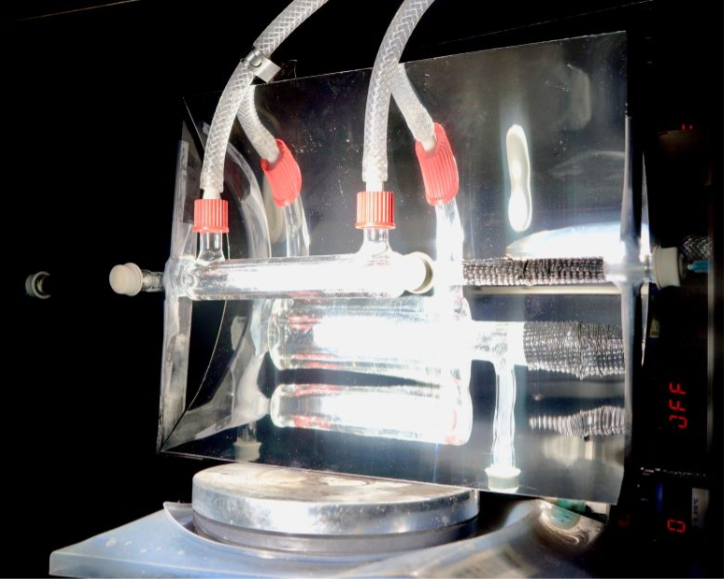


 3:35:33
3:35:33  2025-02-13
2025-02-13  809
809

Scientists have developed a sunlight-powered reactor that directly captures CO2 from the air and transforms it into sustainable fuel.
Unlike traditional carbon capture methods, this device requires no fossil-fuel energy, making it a game-changer for the climate crisis. By mimicking photosynthesis, it produces syngas, a crucial ingredient in fuel and pharmaceuticals, with plans to scale up for liquid fuel production.
Harnessing Sunlight for Sustainable Fuel
Scientists at the University of Cambridge have developed a solar-powered reactor that captures carbon dioxide directly from the air and converts it into sustainable fuel using sunlight.
This innovative reactor has the potential to produce fuel for cars and planes, as well as essential chemicals and pharmaceuticals. It could also provide a reliable energy source in remote or off-grid locations.
Unlike traditional carbon capture technologies, which require fossil fuel energy and involve transporting and storing CO2, this reactor eliminates those steps. Instead, it directly converts atmospheric CO2 into useful products using only sunlight. The research findings were published today (February 13) in Nature Energy.
The Limitations of Conventional Carbon Storage
While Carbon Capture and Storage (CCS) has been promoted as a solution to the climate crisis—receiving £22 billion (~$27 billion) in UK government funding—it remains highly energy-intensive. Additionally, concerns persist over the long-term safety of storing pressurized CO2 deep underground, though ongoing studies are assessing these risks.
“Aside from the expense and the energy intensity, CCS provides an excuse to carry on burning fossil fuels, which is what caused the climate crisis in the first place,” said Professor Erwin Reisner, who led the research. “CCS is also a non-circular process, since the pressurized CO2 is, at best, stored underground indefinitely, where it’s of no use to anyone.”
Turning a Harmful Gas into Useful Chemicals
“What if instead of pumping the carbon dioxide underground, we made something useful from it?” said first author Dr Sayan Kar from Cambridge’s Yusuf Hamied Department of Chemistry. “CO2 is a harmful greenhouse gas, but it can also be turned into useful chemicals without contributing to global warming.”
The focus of Reisner’s research group is the development of devices that convert waste, water, and air into practical fuels and chemicals. These devices take their inspiration from photosynthesis: the process by which plants convert sunlight into food. The devices don’t use any outside power: no cables, no batteries – all they need is the power of the sun.
From Air to Syngas: The Key Breakthrough
The team’s newest system takes CO2 directly from the air and converts it into syngas: a key intermediate in the production of many chemicals and pharmaceuticals. The researchers say their approach, which does not require any transportation or storage, is much easier to scale up than earlier solar-powered devices.
The device, a solar-powered flow reactor, uses specialized filters to grab CO2 from the air at night, like how a sponge soaks up water. When the sun comes out, the sunlight heats up the captured CO2, absorbing infrared radiation and a semiconductor powder absorbs the ultraviolet radiation to start a chemical reaction that converts the captured CO2 into solar syngas. A mirror on the reactor concentrates the sunlight, making the process more efficient.
Towards Liquid Fuels and Scaled-Up Solutions
The researchers are currently working on converting solar syngas into liquid fuels, which could be used to power cars, planes, and more – without adding more CO2 to the atmosphere.
“If we made these devices at scale, they could solve two problems at once: removing CO2 from the atmosphere and creating a clean alternative to fossil fuels,” said Kar. “CO2 is seen as a harmful waste product, but it is also an opportunity.”
A Future Without Fossil Fuels?
The researchers say that a particularly promising opportunity is in the chemical and pharmaceutical sector, where syngas can be converted into many of the products we rely on every day, without contributing to climate change. They are building a larger scale version of the reactor and hope to begin tests in the spring.
If scaled up, the researchers say their reactor could be used in a decentralized way, so that individuals could theoretically generate their own fuel, which would be useful in remote or off-grid locations.
“Instead of continuing to dig up and burn fossil fuels to produce the products we have come to rely on, we can get all the CO2 we need directly from the air and reuse it,” said Reisner. “We can build a circular, sustainable economy – if we have the political will to do it.”
Reality Of Islam |
|

Stanford, C

A new study

Researchers

A new chip-
 9:3:43
9:3:43
 2018-11-05
2018-11-05
10 benefits of Marriage in Islam
 7:5:22
7:5:22
 2019-04-08
2019-04-08
benefits of reciting surat yunus, hud &
 9:45:7
9:45:7
 2018-12-24
2018-12-24
advantages & disadvantages of divorce
 11:35:12
11:35:12
 2018-06-10
2018-06-10
 6:0:51
6:0:51
 2018-10-16
2018-10-16
 6:14:17
6:14:17
 2018-06-21
2018-06-21
 9:39:36
9:39:36
 2022-12-28
2022-12-28
 4:25:57
4:25:57
 2023-02-11
2023-02-11
al-hussain (peace be upon him)
 10:18:1
10:18:1
 2022-09-21
2022-09-21
 7:34:7
7:34:7
 2023-02-28
2023-02-28
 9:42:16
9:42:16
 2022-10-19
2022-10-19
 12:10:56
12:10:56
 2022-11-17
2022-11-17
 5:41:46
5:41:46
 2023-03-18
2023-03-18
| LATEST |